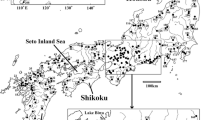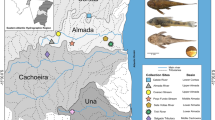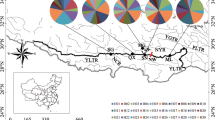Abstract
Despite the high diversity and endemism in the Mobile River Basin, analyses of molecular phylogeographic patterns of freshwater fishes in this system are lacking. Using cytochrome b (cyt b) and S7 ribosomal intron-1, this study compares the phylogeography and population structure of Etheostoma rupestre Rock Darter with a disjunct distribution throughout the Mobile River Basin. For cyt b, parsimony, Bayesian, and Species Delimitation analyses showed a split between the Tombigbee, Alabama, and Coosa/Tallapoosa Rivers, potentially representing previously undescribed species. In addition, there is evidence of limited gene flow between the lower Tombigbee/Sipsey River populations and other populations. Hierarchical comparison showed that there is genetic divergence between the major rivers of the Mobile River Basin. The lack of structure within the tributaries of the river system may indicate that Rock Darter is capable of further dispersal than typical for a darter species. The structure identified across the basin may be due to historic sea-level fluctuations and/or contemporary structure, but fine-scale, within-river analyses would be necessary to further unravel the phylogenetic relationships of the Rock Darter species complex. This study is relevant to establishing conservation guidelines for the biodiversity in the Mobile River Basin.





Similar content being viewed by others
Data availability
The data that support the findings of this study are available from the corresponding author upon reasonable request. The datasets generated during and/or analyzed during the current study are available in the GenBank Repository, OP887044-OP887132.
References
Austin, J. D., H. L. Jelks, B. Tate, A. R. Johnson & F. Jordan, 2011. Population genetic structure and conservation genetics of threatened Okaloosa darters (Etheostoma okaloosae). Conservation Genetics 12: 981–989.
Beneteau, C. L., R. P. Walter, N. E. Mandrak & D. D. Heath, 2012. Range expansion by invasion: genetic characterization of invasion of the greenside darter (Etheostoma blennioides) at the northern edge of its distribution. Biological Invasions 14: 191–201.
Boschung, H. T. & R. L. Mayden, 2004. Freshwater Fishes of Alabama and the Mobile Basin, Smithsonian Press, Washington, DC:
Chow, S. & K. Hazama, 1998. Universal PCR primers for the S7 ribosomal protein gene introns in fish. Molecular Ecology 7: 1255–1256.
Clement, M., D. Posada & K. A. Crandall, 2000. TCS: a computer program to estimate gene genealogies. Molecular Ecology 9: 1657–1659.
Duvernell, D. D., S. L. Meier, J. F. Schaefer & B. R. Kreiser, 2013. Contrasting phylogeographic histories between broadly sympatric topminnows in the Fundulus notatus species complex. Molecular Phylogenetics and Evolution 69: 653–663.
Edgar, R. C., 2004. MUSCLE: a multiple sequence alignment method with reduced time and space complexity. BMC Bioinformatics 5: 113.
Excoffier, L., G. Laval & S. Schneider, 2005. Arlequin (version 3.0): an integrated software package for population genetics data analysis. Evolutionary Bioinformatics 1: 117693430500100000.
Faber, J. E. & M. M. White, 2000. Comparison of gene flow estimates between species of darters in different streams. Journal of Fish Biology 57: 1465–1473.
Fluker, B. L., B. R. Kuhajda, N. J. Lang & P. M. Harris, 2010. Low genetic diversity and small long-term population sizes in the spring endemic watercress darter, Etheostoma nuchale. Conservation Genetics 11: 2267–2279.
Fu, Y. X., 1997. Statistical tests of neutrality of mutations against population growth, hitchhiking and background selection. Genetics 147: 915–925.
Funk, D. J. & K. E. Omland, 2003. Species-level paraphyly and polyphyly: frequency, causes, and consequences, with insights from animal mitochondrial DNA. Annual Review of Ecology, Evolution, and Systematics 341: 397–423.
Ginson, R., R. P. Walter, N. E. Mandrak, C. L. Beneteau & D. D. Heath, 2015. Hierarchical analysis of genetic structure in the habitat-specialist Eastern Sand Darter (Ammocrypta pellucida). Ecology and Evolution 5: 695–708.
Haponski, A. E. & C. A. Stepien, 2013. Phylogenetic and biogeographical relationships of the Sander pikeperches (Percidae: Perciformes): patterns across North America and Eurasia. Biological Journal of the Linnean Society 110: 156–179.
He, S. P., R. L. Mayden, X. Z. Wang, W. Wang, K. L. Tang, W. J. Chen & Y. Y. Chen, 2008. Molecular phylogenetics of the family Cyprinidae (Actinopterygii: Cypriniformes) as evidenced by sequence variation in the first intron of S7 ribosomal protein-coding gene: further evidence from a nuclear gene of the systematic chaos in the family. Molecular Phylogenetics and Evolution 46: 818–829.
Helms, B. S., R. C. Vaught, S. K. Suciu & S. R. Santos, 2015. Cryptic diversity within two endemic crayfish species of the Southeastern US revealed by molecular genetics and geometric morphometrics. Hydrobiologia 755: 283–298.
Hocutt, C. H. & E. O. Wiley, 1986. The Zoogeography of North American Freshwater Fishes, Wiley, New York:
Hoelzer, G. A., 1997. Inferring phylogenies from mtDNA variation: mitochondrial-gene trees versus nuclear-gene trees revisited. Evolution 51: 622–626.
Joachim, R. D., J. M. Guill & D. C. Heins, 2003. Female reproductive life-history traits of the Rock Darter, Etheostoma rupestre, from Flat Creek, Alabama. The American Midland Naturalist 150: 268–275.
Kearse, M., R. Moir, A. Wilson, S. Stones-Havas, M. Cheung, S. Sturrock, S. Buxton, A. Cooper, S. Markowitz, C. Duran, T. Thierer, B. Ashton, P. Mentjies & A. Drummond, 2012. Geneious Basic: an integrated and extendable desktop software platform for the organization and analysis of sequence data. Bioinformatics 28: 1647–1649.
Keck, B. P. & T. J. Near, 2008. Assessing phylogenetic resolution among mitochondrial, nuclear, and morphological datasets in Nothonotus darters (Teleostei: Percidae). Molecular Phylogenetics and Evolution 46: 708–720.
Kozal, L. C., J. W. Simmons, J. M. Mollish, D. J. MacGuigan, E. Benavides, B. P. Keck & T. J. Near, 2017. Phylogenetic and morphological diversity of the Etheostoma zonistium species complex with the description of a new species endemic to the Cumberland Plateau of Alabama. Bulletin of the Peabody Museum of Natural History 58: 263–286.
Lang, N. J. & R. L. Mayden, 2007. Systematics of the subgenus Oligocephalus (Teleostei: Percidae: Etheostoma) with complete subgeneric sampling of the genus Etheostoma. Molecular Phylogenetics Evolution 43: 605–615.
Lavoue, S., J. P. Sullivan & C. D. Hopkins, 2003. Phylogenetic utility of the first two introns of the S7 ribosomal protein gene in African electric fishes (Mormyroidea: Teleostei) and congruence with other molecular markers. Biological Journal of the Linnean Society 78: 273–292.
Lawson, R., 1987. Molecular studies of thamnophiine snakes. I. The phylogeny of the genus Nerodia. Journal of Herpetology 21: 140–157.
Masters, B. C., V. Fan & H. A. Ross, 2011. Species delimitation – a Geneious plugin for the exploration of species boundaries. Molecular Ecology Resources 11: 154–157.
Mayden, R. L., 1987. Historical ecology and North American highland fishes: a research program in community ecology. In Community and Evolutionary Ecology of North American Stream Fishes. University of Oklahoma Press, Norman.
Moore, W. S., 1995. Inferring phylogenies from mtDNA variation: mitochondrial-gene trees versus nuclear-gene trees. Evolution 49: 718–726.
Musilová, Z., O. Rícan, K. Janko & J. Novák, 2008. Molecular phylogeny and biogeography of the Neotropical cichlid fish tribe Cichlasomatini (Teleostei: Cichlidae: Cichlasomatinae). Molecular Phylogenetics and Evolution 46: 659–672.
Near, T. J., T. W. Kassler, J. B. Koppelman, C. B. Dillman & D. P. Philipp, 2003. Speciation in North American black basses, Micropterus (Actinopterygii: Centrarchidae). Evolution 57: 1610–1621.
Near, T. J., C. M. Bossu, G. S. Bradburd, R. L. Carlson, R. C. Harrington, P. R. Hollingsworth Jr., B. P. Keck & D. A. Etnier, 2011. Phylogeny and temporal diversification of darters (Percidae: Etheostomatinae). Systematic Biology 60: 565–595.
Neves, R. J., A. E. Bogan, J. D. Williams, S. A. Ahlstedt & P. W. Hartfield, 1997. Status of aquatic mollusks in the southeastern United States: a downward spiral of diversity. In Benz, G. W. & D. E. Collins (eds), Aquatic Fauna in Peril: The Southeastern Perspective. Decatur (GA): Southeast Aquatic Research Institute Special Publication, Vol. 1: 43–85. Southeast Aquatic Research Institute.
Page, L. M., 1983. Handbook of Darters, TFH Publications Incorporated, Neptune:
Piller, K. R., H. L. Bart & D. L. Hurley, 2008. Phylogeography of the greenside darter complex, Etheostoma blennioides (Teleostomi: Percidae): a wide-ranging polytypic taxon. Molecular Phylogenetics and Evolution 46: 874–985.
Rashleigh, B., M. Cyterski, L. M. Smith & J. A. Nestlerode, 2009. Relation of fish and shellfish distributions to habitat and water quality in the Mobile Bay Estuary, USA. Environmental Monitoring and Assessment 150: 181–192.
Rodrigo, A. G., F. Bertels, J. Heled, R. Noder, H. Shearman & P. Tsai, 2008. The perils of plenty: what are we going to do with all these genes? Philosophical Transactions of the Royal Society London Series b, Biological Sciences 363: 3893–3902.
Roe, K. J. & C. Lydeard, 1998. Molecular systematics of the freshwater mussel genus Potamilus (Bivalvia: Unionidae). Malacologia 39: 195–205.
Roe, K. J., P. D. Hartfield & C. Lydeard, 2001. Phylogeographic analysis of the threatened and endangered superconglutinate-producing mussels of the genus Lampsilis (Bivalvia: Unionidae). Molecular Ecology 10: 2225–2234.
Ronquist, F. & J. P. Huelsenbeck, 2003. MrBayes 3: Bayesian phylogenetic inference under mixed models. Bioinformatics 19: 1572–1574.
Rosenberg, N. A., 2007. Statistical tests for taxonomic distinctiveness from observations of monophyly. Evolution 61: 317–323.
Ross, H. A., S. Murugan & W. L. S. Li, 2008. Testing the reliability of genetic methods of species identification via simulation. Systematic Biology 57: 216–230.
Rozas, J., J. C. Sánchez-DelBarrio, X. Messeguer & R. Rozas, 2003. DnaSP, DNA polymorphism analyses by the coalescent and other methods. Bioinformatics 19: 2496–2497.
Schmidt, T. R. & J. R. Gold, 1993. The complete sequence of the mitochondrial cytochrome b gene in the cherryfin shiner, Lythrurus roseipinnis (Teleostei: Cyprinidae). Copeia 1993: 880–883.
Smith, C. H., N. A. Johnson, J. M. Pfeiffer & M. M. Gangloff, 2018. Molecular and morphological data reveal non-monophyly and speciation in imperiled freshwater mussels (Anodontoides and Strophitus). Molecular Phylogenetics and Evolution 119: 50–62.
Sterling, K. A., D. H. Reed, B. P. Noonan & M. L. Warren, 2012. Genetic effects of habitat fragmentation and population isolation on Etheostoma raneyi (Percidae). Conservation Genetics 13: 859–872.
Strange, R. M. & B. M. Burr, 1997. Intraspecific phylogeography of North American highland fishes: a test of the Pleistocene vicariance hypothesis. Evolution 51: 885–897.
Strayer, D. L. & D. Dudgeon, 2010. Freshwater biodiversity conservation: recent progress and future challenges. Journal of the North American Benthological Society 29: 344–358.
Swift, C. C., C. R. Gilbert, S. A. Bortone, G. H. Burgess & R. W. Yerger, 1986. Zoogeography of the freshwater fishes of the Southeastern United States: Savannah River to Lake Pontchartrain. In The Zoogeography of North American Freshwater Fishes. Wiley, New York.
Tajima, F., 1989. Statistical method for testing the neutral mutation hypothesis by DNA polymorphism. Genetics 124: 585–595.
Tamura, K., J. Dudley, M. Nei & S. Kumar, 2007. MEGA4: molecular evolutionary genetics analysis (MEGA) software version 4.0. Molecular Biology and Evolution 24: 1596–1599.
Tsai, C.-F., 1968. Variation and distribution of the Rock Darter. Copeia 1968: 346–353.
Wiesenfeld, J. C., D. H. Goodman & A. P. Kinziger, 2018. Riverscape genetics identifies speckled dace (Rhinichthys osculus) cryptic diversity in the Klamath-Trinity Basin. Conservation Genetics 19: 111–127.
Williams, J. D., A. E. Bogan & J. T. Garner, 2008. Freshwater mussels of Alabama and the Mobile Basin in Georgia, Mississippi, and Tennessee, University of Alabama Press, Tuscaloosa:
Acknowledgements
We would like to thank Grace Kleiner, Abbey Kleiner, Dan Holt, Katie Lawson, Heath Haley, and Morgan Scarbrough for help with sampling and field assistance. Map and GIS help were kindly provided by Nichelle M. VanTassel. Special thanks go to Mary Freeman and the Georgia Museum of Natural History for collection of samples from the Conasauga and Etowah Rivers.
Funding
Funding for this Project was provided by the Walter F. Cox Research Fund of the Birmingham Audubon Society.
Author information
Authors and Affiliations
Corresponding author
Ethics declarations
Conflict of interest
The authors have no conflict of interest to declare.
Additional information
Handling Editor: Christian Sturmbauer
Publisher's Note
Springer Nature remains neutral with regard to jurisdictional claims in published maps and institutional affiliations.
Rights and permissions
Springer Nature or its licensor (e.g. a society or other partner) holds exclusive rights to this article under a publishing agreement with the author(s) or other rightsholder(s); author self-archiving of the accepted manuscript version of this article is solely governed by the terms of such publishing agreement and applicable law.
About this article
Cite this article
Janosik, A.M., Whitaker, J.M. & Johnston, C.E. Phylogeography and population structure of the Rock Darter species complex, Etheostoma rupestre (Teleostomi: Percidae) across the Mobile River Basin. Hydrobiologia 850, 761–773 (2023). https://doi.org/10.1007/s10750-022-05122-1
Received:
Revised:
Accepted:
Published:
Issue Date:
DOI: https://doi.org/10.1007/s10750-022-05122-1




